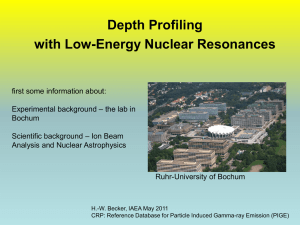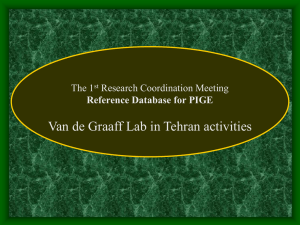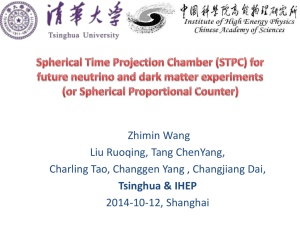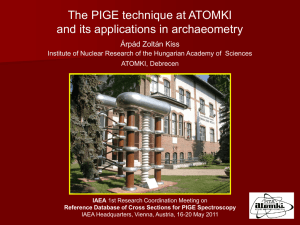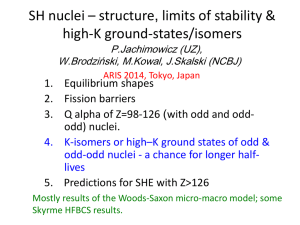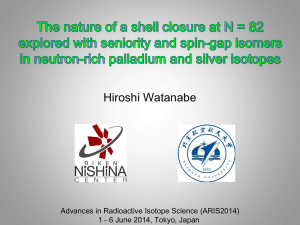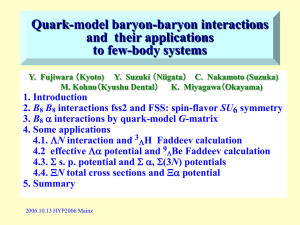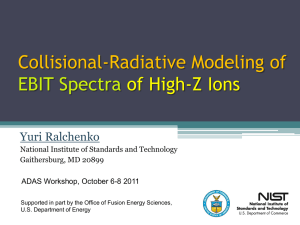PPT - IAEA Nuclear Data Services
advertisement
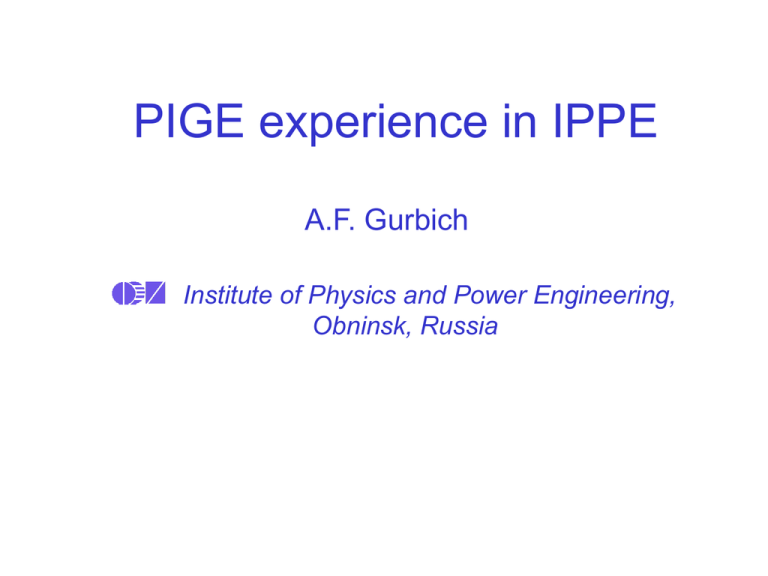
PIGE experience in IPPE A.F. Gurbich Institute of Physics and Power Engineering, Obninsk, Russia Overview • For the analysis of carbon, sodium, aluminum, and chromium resonance PIGE was employed. The excitation functions for the corresponding reactions were measured in the vicinity of resonances favorable for analytical applications. • The oxygen analysis using gammas from direct non-resonant radiative capture was undertaken. • PIGE was used for the analysis of various samples including semiconductor structures and nuclear reactor materials. • Hydrogen analysis using resonance 1H(19F,ag)16O reaction was used to study hydrogen penetration into coating layers on the surface of zirconium pipes. • Propagation of the spectrometer efficiency calibration on the high energy region was made using cascade gamma quanta from the resonance 27Al(p,g)28Si reaction with known gamma ray branching. • Tickonov’s regularization method was applied to resolve the ill-posed problem of the determination of concentration on depth distribution. • Pulsed incident beam was used to substantially enhance the sensitivity of the PIGE analysis due to suppression of the background gamma-radiation. Experimental facilities Thick target yield for resonance The resonance yield per unity solid angle and unity incident particles charge for prompt gamma-rays emission from homogenous target with energy thickness of ET is defined as Y c E N 0 A ( p , g ) E E T dE / dx dE , where N0 - is Avogadro constant, A - is a molecular mass, c - is element concentration in the target. Assuming the Breit-Wigner resonance ( p , g ) R 2 / 4 ( E ER ) 2 2 4 where R - is a cross section at resonance energy ER and - is a resonance width, the yield for an infinitely thick target (ET>>) is Y cN 0 R 2 A dE / dx ( 2 t an 1 E ER / 2 ) The R, , and ER may be regarded as free parameters and these have to be found by fit of theoretical yield to measured data. Thick target yield for the 23Na(p,p’g)23Na reaction (Eg=439 keV) in the vicinity of the resonance and its theoretical description − Bodart F., Deconninck G., Demortier G. Quantitative analysis of sodium by (p,g)-reactions. J. Radioanal. Chem. 35 (1977) 95 − This measurement (target – NaCl, detector – Ge(Li), proton beam from the EG-2.5 Van de Graaff accelerator of IPPE) Deduced resonance parameters ER=1456 1.8 keV and =8.30.8 keV Thick-target yield of gamma rays from the 27Al(p,g)28Si reaction Ex, keV 12549 Gamma-Ray Yield, Rel. Units 400 27 12742 12935 13128 13321 1400 1600 1800 28 Al(p,g) Si Eg= 9-11 MeV 300 200 100 0 1000 1200 Ep, keV Resonance energies are indicated by bars Thick target yield of g-rays at the 991.9 keV resonance in the 27Al(p,g)28Si reaction Proton energy, keV − Deconninck G., Demortier G. Quantitative analysis of aluminium by prompt nuclear reactions. J. Radioanal. Chem. 12 (1972)189. − This measurement PIGE analysis of carbon Ng 12 800 E g =2366 keV кэВ 13 Intense resonances in the reaction 12С(p,g)13N (Q=1944.010.22 keV) are observed at 0.457 and 1.699 MeV. (а) C (p, g ) N E p =550 keV кэВ For the Еp= 457 keV resonance (total width Г=35 keV, resonance crosssection =127 mb) the gray energy is 2.366 MeV. 600 E g =2452 keV кэВ max 400 For the Еp = 1.699 MeV resonance (total width Г=70 keV, resonance crosssection =35 mb) the g-ray energy is 3.51 MeV. 200 0 6 (б) (b) 4 2 0 2000 2100 2200 2300 2400 2500 2600 ray energy ЭGamma нергия гам м а-квантов (a) – graphite (b) – steel (~0.1% of carbon concentration) Excitation function of the 52Cr(p,g)53Mn reaction From R.L.Schulte et al. Nucl. Phys. A243 (1975) 202 Thick target yield of g-rays at the 1005 keV resonance in the 52Cr(p,g)53Mn reaction Proton energy, keV The IAR at Еp = 1005 keV decays mainly through the levels at 2.87 MeV (26%) and 3.18 MeV (20%) whereas the contribution of all other resonances in population of these levels is small. Thus measured spectra contain gamma quanta which are specific only for this resonance. Gamma-ray spectrum (high energy part) for the decay of the IAR at Ep=1005 keV in the 52Cr(p,g)53Mn reaction 100 52 53 C r(p , g ) M n 26% R 80 2 8 7 5 ke V E p= 1 0 2 0 k e V 2497 keV 60 20% R 3 1 8 2 ke V 2804 keV C o u n ts /C h a n n e l E p= 1 0 0 0 k e V 40 20 0 1200 1400 1600 C hannel N um ber 1800 2000 Gamma-ray spectrum (low energy part) for the decay of the IAR at Ep=1005 keV in the 52Cr(p,g)53Mn reaction 3000 378 keV E p= 1 0 2 0 k e V C o u n ts /C h a n n e l E p= 1 0 0 0 k e V 2000 52 53 C r(p , g ) M n 511 keV 1000 0 100 200 300 Channel Num ber 400 Counts/Channel Oxygen analysis using gammas from direct non-resonant radiative capture Channel Number E g (E p ) M M m E p (x ) Q E 1 E g N ( E g , )E N A M ( E p ) ( E g ( E p )) const q c( x ) ( E g ( E p ( x ))) ( E p ( x ), ) x co s The resonance parameters for the 1H(19F,ag)16O reaction ER, MeV 6.418 9.121 , keV 44.1 17.1 Peak value 1675 669 11.198 12.583 15.686 575 80.1 105.5 2954 3867 3039 16.441 17.634 85.4 152.9 69847 38201 The gamma ray yield for the 1H(19F,ag)16O reaction. The EXFOR data for the 19F(p,ag)16O reaction were converted for the case when 19F is a projectile G a m m a R a y Y ie ld , a rb itra ry u n its 600 1 500 19 16 H ( F ,a g ) O 400 300 0 .1 200 100 0 6000 8000 10000 12000 14000 E n e rg y , k e V 16000 18000 20000 A typical spectrum of gamma quanta from the 1H(19F,ag)16O reaction measured with a NaI(Tl) detector at the 19F2+ beam energy of 9.2 MeV 1500 NaI(Tl) 160150 mm 1 1200 Counts/Channel 19 16 H( F,ag) O Eg = 6.13 MeV 900 600 300 0 0 50 100 150 200 250 Channel Number 300 350 400 The spectrum of gamma rays for the 27Al(p,g)28Si reaction from which the spectrometer efficiency for high energy gamma quanta was determined 2 1 I1 S 2 I 2 S1 , Branching for a resonance in the 27Al(p,g)28Si reaction at Ep=767 keV Angular distribution 100 W ( ) 1 A 2 P2 (cos ) A 4 P4 (cos ) 28 Al(p,g) Si 90 120 Ep=767 кэВ 12.323 4.617 MeV 10 60 30 150 4.617 1.779 MeV Probability for emission, % 27 180 0 330 210 240 300 270 Solid line – Eg=7.706 MeV 1 0 1 2 3 4 5 6 g-ray energy, MeV 7 8 9 10 Dashed line – Eg=2.873 MeV Resolving inverse problem using the regularization method In order to derive the concentration on depth distribution c(x) the Fredholm c ( x ) F E , x dx should be resolved. This ill-posed problem was resolved using Tickonov’s equation of the first kind Y E 0 x max 0 0 regularization method. The gamma ray yield The derived hydrogen profile units ед.) arbitrary (отн. Yield, Гамма-выход Gamma-ray yield for the aluminized steel sample 35000 30000 27Al(p,g28Si 25000 20000 15000 10000 5000 0 1000 1100 1200 1300 1400 1500 1600 1700 Ep, keV кэВ Dots – experiment Line – theoretical fit Block diagram of the electronics P rea m p lifie r L o g ic Shaper D e la y P ic k -u p s to p s ta rt T im e to Am p litu d e C o n v e rte r D iffe r e n tia l D is c r im . T a rg e t t D e tec to r Fas t Am p lifie r C o n s ta n t F r ac tio n D is c r . s tro b e P rea m p lifie r E S p e c tr o s c o p ic Am p lifie r An a lo g to D igita l C o n v e rte r Channel Number (Energy) Slits Counts/Channel Counts/Channel 0.75 ns/channel Target Energy and timing spectra Channel Number (Time) Characteristics of the reactions used for PIGE analysis of the BN-600 atomic power plant steam generator wall Reaction g-ray energy, MeV 12C(p,g )13N o 2.366 16O(p,g 17 1) F Resonance energy, MeV 0.457 16/17Ep(x)+0.105 Proton beam energy Depth resolution, Maximal mm depth, mm 0.5 0.2 4 0.8 0.04 3 23Na(p,ag)20Ne 1.634 1.011 1.011-1.070 0.016 0.6 23Na(p,p’g)23Na 0.440 1.283 1300 0.07 52Cr(p,g)53Mn 0.378 1.005 1.005-1.080 0.05 0.8 mass % Sodium distribution near the surface of an oxidized silicon wafer mm The insert shows a part of gamma-spectrum around the sodium line at Eg=439 keV for oxidized () and virgin () samples for irradiation with a proton beam of Ep=1470 keV PIGE analysis of a semiconductor laser structure ~1~ mm 1м км p -э митте р p-emitter p - G a 1-x A lx A s N g (E p ) 650 ~ 0.2mm м км ~0.2 ~0.2 mm А Active ктивны йlayer с ло й p - G aA s nn-emitter - э митте р 4 - 5 mm м км 4-5 n - G a 1-x A lx A s ~0 .8 mm м км 600 550 П оSurface в е р хн о сть 500 ~0 .2 м км mm 450 400 П од слой Sub-layer 4-5 4 - 5 mm м км 350 n - G aA s 300 П од ло ж ка Substrate 980 1000 1020 1040 1060 E p , кэ В keV 1080 1100 1120 1140 Aluminum depth profile near surface of the samples tested in the flow of melted lead. Solid line – results obtained using 27Al(d,p0+1)28Al reaction. Dashed line – PIGE results. 0.45 Virgin 0.40 0.35 0.30 0.25 2000 hours Atomic Concentration 0.4 0.3 0.2 0.1 0.0 3000 hours 0.4 0.3 0.2 0.1 0.0 4000 hours 0.3 0.2 0.1 0.0 0 1 2 Depth, mm 3 Mistakes in PIGE data presentation in IBANDL PIGE data presentation in IBANDL PIGE data problems 18 Na(p,p'g1-0)23Na 23 16 Mateus et al. Caciolli et al. Cross-section, mb 14 12 10 8 6 4 2 2200 2250 2300 2350 Proton energy, keV 2400 2450 Atomic Energy Review Supplement No.2 (1981) J.R. Bird, M.D. Scott, L.H. Russel, M.J. Kenny, Analysis using Ion Induced g Rays. Aust. J. Phys., 31 (1978) 209.
